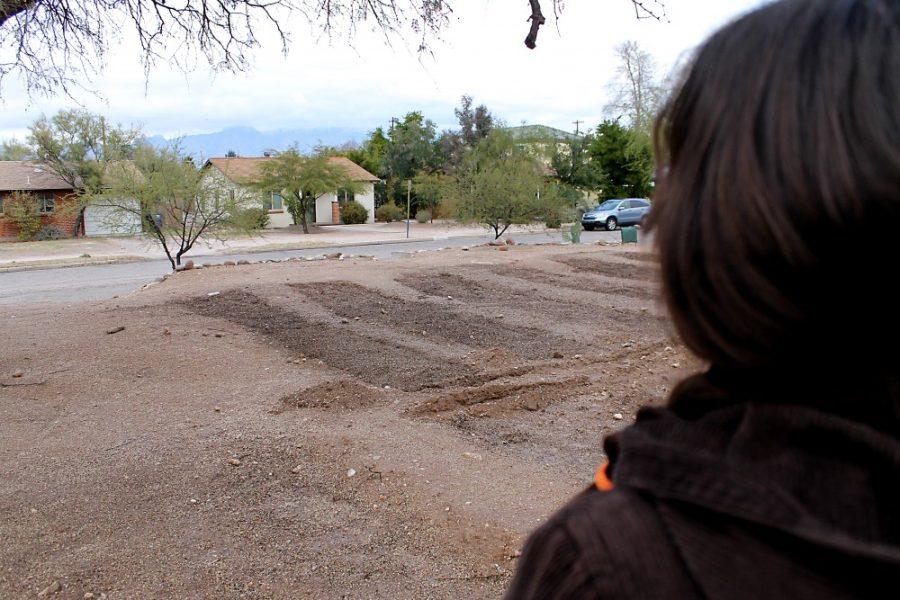With the UA Community Garden, Students for Sustainability and ASUA are working to close the gap between the university and surrounding communities.
The UA Community Garden, an effort that has been in development throughout the course of the last year, is in its final planning stages. Open to anyone, the garden provides a place for a person or group of people to rent out a plot and grow a number of plants, primarily for food.
The garden is located at the corner of East Mabel Street and North Highland Avenue, adjacent to the northeast corner of the Highland Avenue Parking Garage. The area contains 42 sunken beds, some measuring 18 by 3 feet, others 20 by 3 feet.
While other entities, such as the UA Office of Sustainability, the Associated Students of the University of Arizona and the UA Department of Soil, Water and Environmental Science are involved, Students for Sustainability headed the project.
“As far as the management aspect of it, we want this to be very student-run, very student oriented,” said Sofia Montes, a fall 2011 graduate in crop production and former co-project manager of the Garden in the Desert project. “So it’s been mostly just a lot of student volunteer work.”
But despite the project’s independence, collaborations with colleges and other departments are a possibility.
“We haven’t really established a solid partnership with very many people besides ASUA and Students for Sustainability,” Montes added. “But that’s definitely a future goal. We want to have classes taught here as well.”
Given the department in charge of the project, it’s no surprise that sustainability is a primary consideration. The garden’s irrigation system runs on a solar-powered timer, and will run at night to minimize water evaporation. Additionally, the garden will use compost from the Student Union Memorial Center, a resource that would otherwise be food waste.
“We built it with the idea in mind that it’s going to be as sustainable as it can be and we’re going to do everything to mitigate the amount of resources that we’re using for it,” said Natalie Lucas, executive program director of Students for Sustainability.
According to Lucas, the project is already sustainable by nature. Keeping food local reduces the carbon emissions it takes to transport food from other locations. But the sustainability efforts are never-ending, and there are still more plans to make the project even greener.
The installation of a rainwater-harvesting cistern on the Highland Avenue Parking Garage to make water usage more efficient is also a potential addition, as well as using 100 percent recycled materials to market the project.
According to Chet Phillips, a graduate assistant for sustainability and one of the Garden in the Desert’s project coordinators, funding for the project came from various sources, primarily from the UA Green Fund. The fund, initially approved in March of 2010, accumulates about $400,000 each year from tuition and fees, which it then uses to fund projects that enhance the UA’s sustainability efforts, like the UA Community Garden.
Phillips said that members of the project don’t intend to remain dependent on the Green Fund forever, and will also apply for other local and community grants in the future.
Phillips also said that the garden complements the UA’s reputation as a research institution, and student research involvement is a definite possibility. The potential future installation of the rainwater-harvesting cistern has already caught the attention of researchers in the soil, water and environmental science department, where researchers are interested in studying how crop production may differ with the use of rainwater versus irrigated water.
“That’s the kind of baseline research that we need to know — whether harvested rainwater could be a source food production into the future,” Phillips said. “That’s an actual research grant that we’re working on right now. That would be research that would involve faculty in the soil, water and environmental science department and students involved in the garden.”
While there are many perks to having a garden on campus that anyone can use, many have agreed that the UA Community Garden’s main goal is to bring the university and the surrounding community together.
“That’s really the biggest point of this garden,” Lucas added. “It makes people think a little bit more about where their food is coming from and how it can impact them. This is a way to connect people in the city to something that is very simple and of essence.”









